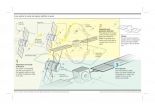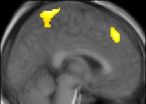(Press-News.org) STANFORD, Calif. — Intense, passionate feelings of love can provide amazingly effective pain relief, similar to painkillers or such illicit drugs as cocaine, according to a new Stanford University School of Medicine study.
"When people are in this passionate, all-consuming phase of love, there are significant alterations in their mood that are impacting their experience of pain," said Sean Mackey, MD, PhD, chief of the Division of Pain Management, associate professor of anesthesia and senior author of the study, which will be published online Oct. 13 in PLoS ONE. "We're beginning to tease apart some of these reward systems in the brain and how they influence pain. These are very deep, old systems in our brain that involve dopamine — a primary neurotransmitter that influences mood, reward and motivation."
Scientists aren't quite yet ready to tell patients with chronic pain to throw out the painkillers and replace them with a passionate love affair; rather, the hope is that a better understanding of these neural-rewards pathways that get triggered by love could lead to new methods for producing pain relief.
"It turns out that the areas of the brain activated by intense love are the same areas that drugs use to reduce pain," said Arthur Aron, PhD, a professor of psychology at State University of New York at Stony Brook and one of the study's authors. Aron has been studying love for 30 years. "When thinking about your beloved, there is intense activation in the reward area of the brain — the same area that lights up when you take cocaine, the same area that lights up when you win a lot of money."
The concept for the study was sparked several years ago at a neuroscience conference when Aron, an expert in the study of love, met up with Mackey, an expert in the research of pain, and they began talking.
"Art was talking about love," Mackey said. "I was talking about pain. He was talking about the brain systems involved with love. I was talking about the brain systems involved with pain. We realized there was this tremendous overlapping system. We started wondering, 'Is it possible that the two modulate each other?'"
After the conference, Mackey returned to Stanford and collaborated with postdoctoral scholar Jarred Younger, PhD, now an assistant professor of anesthesia, who was also intrigued with the idea. Together the three set up a study that would entail examining the brain images of undergraduates who claimed to be "in that first phase of intense love."
"We posted fliers around Stanford University and within hours we had undergrads banging on our door," Mackey said. The fliers asked for couples who were in the first nine months of a romantic relationship.
"It was clearly the easiest study the pain center at Stanford has ever recruited for," Mackey said. "When you're in love you want to tell everybody about it.
"We intentionally focused on this early phase of passionate love," he added. "We specifically were not looking for longer-lasting, more mature phases of the relationship. We wanted subjects who were feeling euphoric, energetic, obsessively thinking about their beloved, craving their presence.
"When passionate love is described like this, it in some ways sounds like an addiction. We thought, 'Maybe this does involve similar brain systems as those involved in addictions which are heavily dopamine-related.' Dopamine is the neurotransmitter in our brain that is intimately involved with feeling good."
Researchers recruited 15 undergraduates (eight women and seven men) for the study. Each was asked to bring in photos of their beloved and photos of an equally attractive acquaintance. The researchers then successively flashed the pictures before the subjects, while heating up a computer-controlled thermal stimulator placed in the palm of their hand to cause mild pain. At the same time, their brains were scanned in a functional magnetic resonance imaging machine.
The undergraduates were also tested for levels of pain relief while being distracted with word-association tasks such as: "Think of sports that don't involve balls." Scientific evidence has shown in the past that distraction causes pain relief, and researchers wanted to make sure that love was not just working as a distraction from pain.
Results showed that both love and distraction did equally reduce pain, and at much higher levels than by concentrating on the photo of the attractive acquaintance, but interestingly the two methods of pain reduction used very different brain pathways.
"With the distraction test, the brain pathways leading to pain relief were mostly cognitive," Younger said. "The reduction of pain was associated with higher, cortical parts of the brain. Love-induced analgesia is much more associated with the reward centers. It appears to involve more primitive aspects of the brain, activating deep structures that may block pain at a spinal level — similar to how opioid analgesics work.
"One of the key sites for love-induced analgesia is the nucleus accumbens, a key reward addiction center for opioids, cocaine and other drugs of abuse. The region tells the brain that you really need to keep doing this," Younger said.
"This tells us that you don't have to just rely on drugs for pain relief," Aron said. "People are feeling intense rewards without the side effects of drugs."
###
Other Stanford contributors include research assistants Sara Parke and Neil Chatterjee.
Funding for the study was received from the Chris Redlich Pain Research Fund. Information about the Department of Anesthesia, which also supported the research, is available at http://med.stanford.edu/anesthesia/.
The Stanford University School of Medicine consistently ranks among the nation's top medical schools, integrating research, medical education, patient care and community service. For more news about the school, please visit http://mednews.stanford.edu. The medical school is part of Stanford Medicine, which includes Stanford Hospital & Clinics and Lucile Packard Children's Hospital. For information about all three, please visit http://stanfordmedicine.org/about/news.html.
END
The desire for a quick-fix for obesity fuels a lucrative market in so-called natural remedies. But a study of medical records in Hong Kong revealed 66 cases where people were suspected to have been poisoned by a "natural" slimming therapy. In eight cases the people became severely ill, and in one case the person died. The study is published today in the British Journal of Clinical Pharmacology.
The researchers looked at the ingredients in the 81 slimming products that these people had taken. They found 12 different agents that fell into five categories: undeclared weight-loss ...
WHAT: Two studies appearing in the October 14, 2010 New England Journal of Medicine and funded by the National Institutes of Health helped influence the World Health Organization (WHO) to change its guidelines this year for the treatment of HIV infection in certain women and children. The recently updated guidelines affect HIV-infected women who receive a single dose of the antiretroviral drug nevirapine to prevent HIV transmission to their babies, and infants who receive a single dose of nevirapine to prevent acquiring the virus from their HIV-infected mothers but nevertheless ...
Titusville, NJ, October 13, 2010 – According to a new survey sponsored by Janssen®, Division of Ortho-McNeil-Janssen Pharmaceuticals, Inc, 94 percent of psychiatric nurses feel very or extremely involved in providing care for people with mental illness. Although some psychiatric nurses believe that their specialty is as difficult as or more difficult than oncology nursing, or emergency nursing, one-third would prefer to be more involved in patient care than they are now. The survey also revealed that psychiatric nurses believe their work affects patient care, with more ...
There may be a fundamental link between aspects of an individual's personality and their capacity to exercise or generate energy, recent research suggests.
Humans are not the only animals that choose to exercise and – as with people - individuals within the same species differ in their levels of activity, says Dr Peter Biro, a senior lecturer in the UNSW Evolution and Ecology Research Centre, in a review article in the journal Trends in Ecology and Evolution, with colleague Judy Stamps of the University of California, Davis. Dr Biro is an Australian Research Council Future ...
An Australian team of scientists has uncovered a quality control mechanism that must take place for our immune system to subsequently effectively destroy harmful viruses and bacteria.
The findings were published today in the prestigious international journal Nature.
The team solved a 15-year puzzle by working out the structure and function of a protein called pre T alpha that is essential in guiding the correct expression of various receptors expressed by T lymphocytes, white blood cells of the immune system.
These receptors, known as T cell receptors, recognise ...
Jerusalem, Oct. 13, 2010 – Unlike humans, honey bees, when thrown into highly time-altered new societal roles, are able to alter their biological rhythms with alacrity, enabling them to make a successful "quick switch" in their daily routines, according to research carried out at the Hebrew University of Jerusalem.
With people, on the other hand, disturbances to their biological clocks by drastic changes in their daily schedules are known to cause problems -- for example for shift workers and for new parents of crying, fitful babies. Disturbance of the biological clock ...
Those who do a lot of driving know how tiring long car trips and night driving can be. And a simple fraction of a second can decide the difference between life and death. According to the German Road Safety Council e.V. (DVR), one in four highway traffic fatalities is the result of momentary driver drowsiness. Researchers at the Fraunhofer Institute for Digital Media Technology IDMT in Ilmenau, Germany, have developed an assistant system that tracks a driver's eye movements and issues a warning before the driver has an opportunity to nod off to sleep.
The special feature ...
Within the framework of this research project, "Acoplamiento y Agarre de Satélites mediante Sistemas Robóticos basado en Visión (Docking and Capture of Satellites through computer vision) (ASIROV)", the scientists have developed algorithms and strategies to dock and capture a disabled satellite through the use of a space vehicle, called a "chaser", which autonomously carries out this function. "In this way", explained the head of this research study, Mohamed Abderrahim, who is from the UC3M Department of Automated Systems Engineering, "we attempt to carry out all ...
DES MOINES, IOWA (14 October 2010)—Crop specialists in Kenya and Uganda have laid the groundwork for confined field trials to commence later this year for new varieties of maize genetically modified to survive recurrent droughts that threaten over 300 million Africans for whom maize is life, according to a speech given today by the head of the African Agricultural Technology Foundation (AATF) at the World Food Prize Symposium.
Scientists working with AATF believe it's important to explore the potential of biotechnology to maintain and increase food production in Africa, ...
Learning from competitors is a critically important form of learning for animals and humans. A new study has used brain imaging to reveal how people and animals learn from failure and success.
The team from Bristol University led by Dr Paul Howard-Jones, Senior Lecturer in Education in the Graduate School of Education and Dr Rafal Bogacz, Senior Lecturer in the Department of Computer Science, scanned the brains of players as they battled against an artificial opponent in a computer game.
In the game, each player took turns with the computer to select one of four ...


